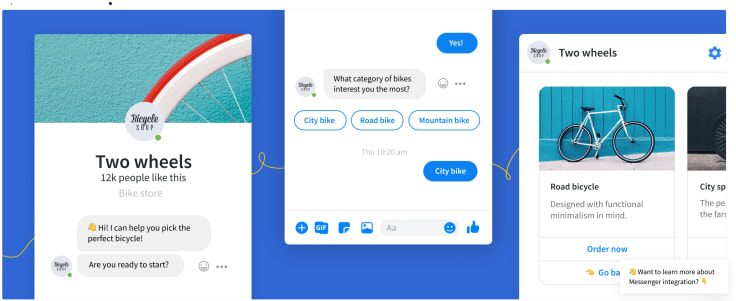Showing top 0 results 0 results found
Showing top 0 results 0 results found

Providing an exceptional user experience lets many ecommerce companies overcome competitors and become market leaders. According to a PwC study, 73% of consumers say that support service experiences are more critical to purchasing than price or product features.
2023 has been a challenging year for the ecommerce industry. The recent pandemic, which affected the explosive growth of online shopping, shook the market. Last year, it had the potential to start stabilizing. The online shopping market instead focused on fighting the effects of rising inflation, wars, and the economic crisis.
Despite the difficulties, the ecommerce market continues to grow, but the pace of development could have been more dynamic between 2020 and 2022.

I gathered the most essential ecommerce trends for 2024 so you’ll know what to focus on this year.
What is customer support, and why does it matter?
Generally speaking, support seeks to help customers make the most of your product or service and, ultimately, solve the issues that brought them to your business.
Although “ecommerce customer support” and “ecommerce customer service” are sometimes interchangeable, they are not identical. While the latter designates all interactions that seek to enhance customer experience, the former is one such interaction that aims to solve a particular issue.
The quality of ecommerce support can make or break a company's competitiveness. Ecommerce customers expect quick and easy solutions to their problems. Online clients will gladly look elsewhere if your company's customer support needs to improve.
Excellent customer support can help you attract new business and build lasting relationships with existing customers, boosting retention and increasing online sales. Satisfied customers will likely purchase from you again and recommend your company to friends, family, and strangers online.
Here are a few statistics that prove why a proper customer support team is a crucial part of every business and how it can give you that competitive edge:
- CX Trends Report found that 73% of consumers will switch to a competitor after experiencing multiple negative interactions.
- Nearly half of consumers want to spend more on a brand that personalizes their ecommerce experience. (Channel Sight)
- 40% of users don’t care whether a real person or a chatbot interacts with them as long as their issue resolution meets customer expectations.
Ecommerce customer service trends in 2024
Are you ready? Let's jump into 2024 trends in ecommerce customer service!
#1 Personalized shopping and customer experience
This year, companies can provide personalized shopping experiences at scale thanks to advanced technology and growing consumer comfort with artificial intelligence (AI).
It's a trend worth betting on, as it paves the way for the rise of personalized marketing campaigns, refined product recommendations, and enhanced experiences on ecommerce sites. Your business can increase customer satisfaction and brand loyalty by catering to customers' unique preferences.
To achieve this, you must collect and analyze extensive customer data. Personalized product recommendations will help shoppers discover products in line with their interests, while tailored email marketing campaigns are expected to create loyal customers to increase engagement and conversions.
You can take a personal approach to your customers by installing ChatBot on your website and using an ecommerce template that allows you to:
- show off your products,
- add products to carts,
- promote special deals,
- track packages,
- show store location,
- make a call,
- provide contact details.

#2 Artificial intelligence
Of course, it is no longer inevitable that AI will also be one of the year's trends.
As AI evolves and shows its flesh, it is becoming a key force in shaping digital marketing strategies, including yours.
The role of AI extends to various touchpoints during the online shopping journey, offering the potential to automate basic ecommerce marketing tasks such as campaign creation and management.
Artificial intelligence uses advanced algorithms to personalize customer experience by analyzing customer demographics, purchase history, and website behavior.
AI-based chatbots are also growing in importance, providing 24/7 customer service, understanding queries, and offering appropriate responses. ChatBot, ideally suited for customer support, utilizes artificial intelligence technologies to help your customers through the purchasing process.

#3 Voice and image search
Another critical trend shaping ecommerce will be voice and image search.
Voice search is a technology that allows users to search for information using voice commands and speech-to-text conversion. It is becoming increasingly popular as a natural and convenient way for people to find information. Retailers are recognizing its growing importance, as the global value of ecommerce transactions with voice assistants was expected to reach around $20 billion in 2023.
So think about optimizing websites for voice search, including incorporating natural language keywords and structured data tags and creating voice-activated product demonstrations and customer service chatbots.
On the other hand, image search is becoming increasingly popular among users who want to find products by uploading images or providing visual descriptions.
Meanwhile, the growing intelligence of smart speakers and assistants means that around 40% of internet users in the US are now using voice assistants every month. To stay ahead of the competition, your ecommerce brand should optimize its website for voice commerce.
This involves focusing on natural language patterns in your content and creating a seamless user experience that can be activated through voice commands.
#4 Social commerce
Social commerce is experiencing significant growth as more and more companies embrace the trend of making their products available for purchase directly on social media platforms such as Instagram and TikTok.
Social commerce seamlessly integrates the shopping experience with these platforms, allowing customers to browse products, read reviews, and transact on their social media channels without leaving the platform.
While some businesses may be hesitant to move away from traditional ecommerce platforms altogether, recognizing that 53% of shoppers find it difficult to trust products sold via social media, it is essential to use social media to build brand awareness, engage customers, and build relationships.
Furthermore, direct messages (DMs) on platforms such as Instagram and Facebook Messenger increasingly serve as customer service interaction channels, offering customers a personalized and convenient way to address concerns, ask questions about products, and seek assistance.
To give your customers the best experience and an easy way to contact your customer service team, check ChatBot integration with Facebook Messenger. This lets you send automated messages to your customers and quickly resolve their problems.

#5 Omnichannel
Customer support available via multiple channels, such as email, call center, live chat, and social media, has become the industry standard in many ecommerce businesses.
Customers want to contact your company through their preferred channel from their select device - most commonly a mobile phone - at their preferred time. When customers can choose how they reach out to your business, they will feel more in control, connected, and more satisfied with their more proactive customer service experience.
To fully optimize the effectiveness of your support team, you should integrate different channels into a single system for information sharing. Software solutions can integrate CRM platforms, allowing real-time information sharing across various communication channels.
#6 Go green or go home
Consumers, increasingly affected by climate change, will continue to prioritize environmentally friendly options. This trend reflects a growing awareness of environmental issues, prompting consumers to seek out actively and favor companies committed to sustainability.
A willingness to pay a premium for sustainable goods indicates a shift towards more conscious consumer behavior. However, the increase in demand for environmentally friendly options is accompanied by growing skepticism, particularly in the US, where a significant proportion of consumers, 60% according to a Mintel consumer report, believe that many companies are engaging in “greenwashing” or pretending to be sustainable without real commitment.
The report highlights that industry accreditation is needed more than waiting for regulatory pressure to meet consumer expectations. To thrive in this landscape, you must embrace sustainability and demonstrate tangible and authentic progress towards meaningful sustainability goals.
Younger consumers, in particular, seek brands that align with their values, emphasizing the importance of a sincere commitment to sustainability to gain and retain their support.
#7 Subscription-based models
Subscription-based models have become attractive for companies and consumers, providing a structured framework for cyclical access to products or services in exchange for a regular fee.
This model provides predictable revenue streams for companies while providing consumers with the convenience of ongoing access to desired goods or services. Whether it is cyclical delivery, exclusive content, or usage privileges, the subscription model caters to various industries, from meal delivery services to streaming platforms.
Its versatility makes it an attractive choice for businesses looking to capitalize on its convenience. Moreover, the subscription model's ability to generate recurring revenue aligns with the changing dynamics of consumer preferences, fostering customer loyalty and retention.
Grow your ecommerce business with ChatBot
Providing excellent customer service is critical to creating a superior user experience, translating into customer loyalty. As you have read in this article, the most important aspects of good customer service are speed and convenience, followed immediately by personalization.
Including automation in the customer service strategy is essential to optimize the support process and make it as fast and efficient as possible.
ChatBot is the perfect solution for you. It is an AI-powered tool that provides continuous customer support. It scans your website, help center, or other designated resource to deliver quick and precise AI-generated answers to customer queries. With ChatBot, you don't need any coding skills to get started. It is the best chatbot app to help your business grow. You can sign up for a free 14-day trial now.



